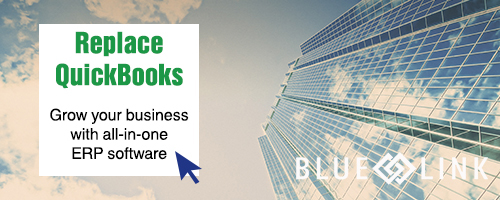You awoke one day and realized that it’s time for a change: “QuickBooks has to go”. It has served your organization well over the years – its simplicity its greatest strength – but now the limitations of QuickBooks are putting the brakes on your rapidly growing business. What to do?
The obvious answer is to replace QuickBooks with ERP software to fully manage not only your accounting, but your inventory and contacts as well. The problem: you may encounter some resistance. Of course, you may be emotionally tied to QuickBooks yourself or, worse yet, your accountant may be adamantly opposed to changing systems.
Resistance to change is a common problem in many industries but is particularly apparent in the software space. It can be difficult to overcome, but with priorities set and objectives clearly defined, change can be accomplished. Focus on the limitations brought on by QuickBooks and make it clear (in your mind and theirs) that you need something more robust and scalable.
Here are some examples of objectives:
Improve reporting
- QuickBooks is great for bookkeeping, but when it comes to delving down deep into historical data, identifying trends and making major business decisions, there simply isn’t enough depth or breadth of business data available
Eliminate double-entry and keying errors
- If you have multiple systems your staff is probably spending a great deal of time duplicating information which can lead to keying errors
Improve accounting integrity
- QuickBooks is flexible – too flexible. Lack of audit trails and the ability to erase transactions entirely can severely compromise data integrity – which was less problematic when you were a small business, but as you’ve grown this has become a recipe for potential disaster
Lack of inventory control
- Get a grip on live inventory information, including costing, quantities and reorder levels by ditching software that focuses primarily on bookkeeping.
QuickBooks may be familiar to you or your staff right now, but familiarity comes with time and can be attained with any user-friendly system. Of course, it helps to determine the level of resistance you are about to encounter when trying to replace QuickBooks. It helps to get everyone on board with the change by involving them in the process, and ensuring that they understand why moving on is important for business growth.
The next question is, are you financially ready to replace QuickBooks? Many businesses start with QuickBooks for a reason – it is very inexpensive. Once you’ve experienced significant growth and begin to notice its limitations, you’re ready to start thinking about the next step.
So how much will the next step cost? Using our ERP Software Pricing Guide you can begin to set realistic expectations of what it will cost to move onto the next level of business software. Depending on your budget, it may not be realistic to move onto a fully integrated system (but the benefits cannot be overstated). A middle-tier system, as opposed to an introductory system like QuickBooks, can carry your business for decades.
Are you ready to replace QuickBooks? Download this guide to help you transition from QuickBook onto an all-in-one ERP solution.











